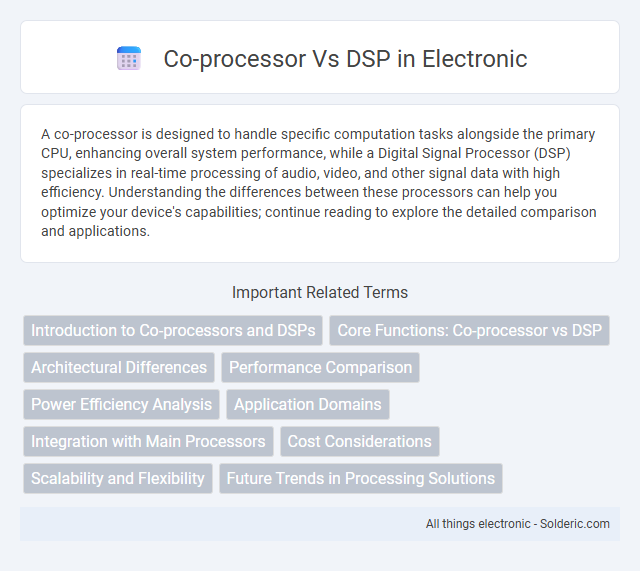A co-processor is designed to handle specific computation tasks alongside the primary CPU, enhancing overall system performance, while a Digital Signal Processor (DSP) specializes in real-time processing of audio, video, and other signal data with high efficiency. Understanding the differences between these processors can help you optimize your device's capabilities; continue reading to explore the detailed comparison and applications.
Comparison Table
| Feature | Co-processor | Digital Signal Processor (DSP) |
|---|---|---|
| Primary Function | Assists CPU by handling specific tasks | Specialized for real-time signal processing |
| Architecture | Varies based on task (e.g., math, graphics) | Optimized for arithmetic and signal operations |
| Processing Speed | Speeds up CPU tasks selectively | High-speed processing for audio, video, and communication |
| Application | Floating-point math, graphics, encryption | Audio, speech, radar, image processing |
| Integration | External or internal adjunct to CPU | Often embedded within SoC or standalone chip |
| Flexibility | Task-specific, varies by co-processor type | Programming optimized for signal algorithms |
Introduction to Co-processors and DSPs
Co-processors and DSPs (Digital Signal Processors) enhance computing systems by offloading specialized tasks from the main CPU, improving performance and efficiency. Co-processors handle specific functions like floating-point arithmetic, graphics, or encryption, while DSPs are optimized for real-time processing of audio, video, and signal data using specialized instruction sets. Understanding your system's requirements helps determine whether a co-processor or DSP will best accelerate your applications and optimize resource use.
Core Functions: Co-processor vs DSP
Co-processors handle specialized tasks such as floating-point arithmetic or encryption to offload the main CPU, enhancing overall system efficiency. Digital Signal Processors (DSPs) are optimized for real-time signal processing tasks like audio, video, and communications through fast mathematical computations. Understanding these core functions helps you choose the right processor for specific computational needs, balancing performance and power consumption.
Architectural Differences
Co-processors are specialized processing units designed to offload specific tasks from the main CPU, often integrating tightly with the system architecture to enhance parallel processing capabilities. Digital Signal Processors (DSPs) feature a unique architecture optimized for real-time signal processing, including specialized instruction sets, multiple execution units, and hardware support for operations like multiply-accumulate (MAC). Understanding these architectural differences enables you to choose the appropriate processor type based on the computational requirements and data throughput demands of your application.
Performance Comparison
Co-processors deliver enhanced multitasking capabilities by offloading specific tasks from the main CPU, improving overall system efficiency, while Digital Signal Processors (DSPs) excel in executing real-time signal processing with high-speed arithmetic operations optimized for audio, video, and communications. DSPs typically achieve lower latency and higher throughput in repetitive, mathematically intensive workloads due to specialized architectures such as SIMD and MAC units, whereas co-processors offer versatile processing that can handle various types of instructions beyond signal processing. Your choice between co-processor and DSP depends on whether your application prioritizes specialized signal processing performance or broader computational offloading to enhance system responsiveness.
Power Efficiency Analysis
Co-processors and DSPs differ significantly in power efficiency, with DSPs designed specifically for signal processing tasks, often delivering higher efficiency for repetitive mathematical operations. Your choice between a co-processor or DSP should consider the workload type, as DSPs optimize power consumption by handling specialized algorithms, while general co-processors may consume more power in diverse tasks. Evaluating power efficiency metrics such as energy per instruction and workload-specific throughput will help optimize your system's overall energy performance.
Application Domains
Co-processors excel in handling complex mathematical computations and graphics rendering, making them ideal for scientific simulations, cryptography, and image processing applications. Digital Signal Processors (DSPs) specialize in real-time audio, speech, and video signal processing, commonly used in telecommunications, audio equipment, and embedded systems. Both technologies are integral in automotive systems, where co-processors manage advanced driver-assistance tasks while DSPs process sensor and communication signals.
Integration with Main Processors
Co-processors are designed to work alongside main processors by handling specific tasks such as floating-point calculations or encryption, offering seamless integration through shared memory and bus interfaces. DSPs (Digital Signal Processors) are specialized co-processors optimized for real-time signal processing tasks, often tightly coupled with the main CPU to enable rapid data exchange and high throughput. Your choice between a co-processor and a DSP depends on the required processing capability and the level of integration necessary for efficient system performance.
Cost Considerations
Co-processors generally incur higher initial costs due to specialized hardware design but can reduce overall system expenses by offloading intensive tasks from the main CPU, enhancing performance efficiency. DSPs (Digital Signal Processors) offer cost-effective solutions for signal processing applications, often integrating a wide range of functions on a single chip, which minimizes system complexity and reduces development costs. Evaluating cost considerations involves balancing the investment in co-processor hardware against the specific signal processing requirements and long-term savings in power consumption and processing speed.
Scalability and Flexibility
Co-processors offer high scalability by offloading specific tasks from the main CPU, enabling parallel processing and improved performance for complex workloads. DSPs (Digital Signal Processors) provide specialized flexibility tailored for real-time signal processing, audio, and communication applications through dedicated instruction sets and architecture. Your choice depends on whether you need broad task scalability with co-processors or fine-tuned flexibility with DSPs for signal-centric tasks.
Future Trends in Processing Solutions
Future trends in processing solutions emphasize the integration of co-processors and digital signal processors (DSPs) to enhance computing efficiency and specialized task handling. Co-processors increasingly support AI workloads and machine learning accelerations, while DSPs evolve with advanced architectures optimized for real-time audio, video, and sensor data processing. The convergence of these technologies facilitates heterogeneous computing platforms that deliver higher performance, lower power consumption, and improved scalability for emerging applications in IoT, automotive, and mobile devices.
Co-processor vs DSP Infographic

 solderic.com
solderic.com